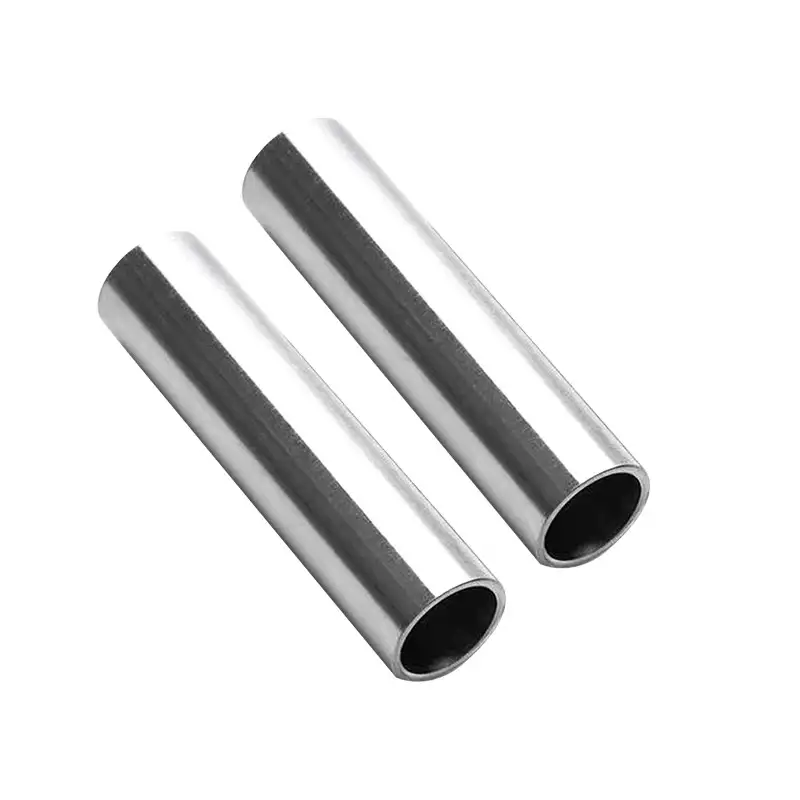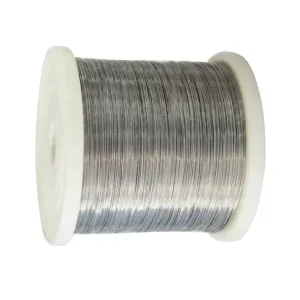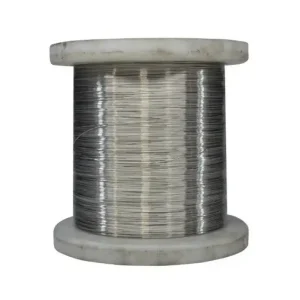Monel Alloy K‑500 (UNS N05500) builds on Monel 400 by including approximately 2.3–3.15% aluminum and 0.35–0.85% titanium. This addition, along with age-hardening treatment, results in a precipitation of Ni₃(Ti, Al) phases, delivering notably higher strength while retaining corrosion resistance.
Specifications & Parameters
| Category | Property | Value / Specification | Condition / Notes |
|---|---|---|---|
| Chemical Composition | Nickel (Ni) | 63.0–70.0% | Base element |
| Copper (Cu) | 27.0–33.0% | Primary alloying element | |
| Aluminum (Al) | 2.3–3.15% | Precipitation hardening element | |
| Titanium (Ti) | 0.35–0.85% | ||
| Iron (Fe) | ≤2.0% | ||
| Manganese (Mn) | ≤1.5% | ||
| Carbon (C) | ≤0.25% | ||
| Silicon (Si) | ≤0.50% | ||
| Sulfur (S) | ≤0.01% | ||
| Physical Properties | Density | 8.44–8.80 g/cm³ (0.305–0.318 lb/in³) | |
| Melting Range | 1300–1350°C (2372–2462°F) | ||
| Electrical Resistivity | 51–62 μΩ·cm | At 20°C | |
| Thermal Conductivity | 17.5–22.0 W/m·K | At 100°C | |
| Coefficient of Thermal Expansion (20–100°C) | 13.4–13.9 × 10⁻⁶/°C | ||
| Elastic Modulus | 179–214 GPa (26,000–31,000 ksi) | ||
| Magnetic Permeability | <1.005 (Non-magnetic below −101°C/−150°F) | ||
| Mechanical Properties | Tensile Strength | 690–1310 MPa (100–190 ksi) | Varies by product form/condition |
| Yield Strength (0.2% Offset) | 276–827 MPa (40–120 ksi) | ||
| Elongation (A5) | 15–45% | ||
| Hardness | 172–413 HB (Brinell) 35–40 HRC (Rockwell C) |
Precipitation-hardened state | |
| Thermal Properties | Continuous Service Limit (Air) | ≤650°C (1202°F) | Oxidation resistance |
| Stress Rupture Strength (600°C/1,000h) | ~40 MPa (5.8 ksi) | ||
| Corrosion Resistance | Seawater | Excellent (resists pitting/SCC in flowing seawater; risk in stagnant water) | |
| Hydrofluoric Acid (HF) | Exceptional resistance | Superior to most alloys | |
| Alkalis & Organic Acids | Highly resistant | ||
| Chloride Stress Corrosion Cracking (SCC) | Near-immunity | ||
| Heat Treatment | Solution Annealing | 870–980°C (1600–1800°F), rapid cool | Optimizes ductility |
| Precipitation Hardening | 480–650°C (900–1200°F), 4–16h hold | Enhances strength via γ' phase (Ni₃(Al,Ti)) | |
| Fabrication | Welding | TIG/MIG with ERNiCu-7 filler Must be done in annealed state; stress-relieve before aging |
|
| Machinability | Challenging (high work-hardening; requires carbide tools/low speeds) | ||
| International Standards | Bar/Rod | ASTM B164, AMS 7234 | Aerospace grade |
| Plate/Sheet | ASTM B127, AMS 4553 | ||
| Tubing/Pipe | ASTM B165, AMS 4676 | ||
| Forgings | ASTM B564 | ||
| Key Applications | Marine Engineering | Pump shafts, propeller blades, seawater valves, fasteners | |
| Oil & Gas | Drill collars, valve stems, downhole tools (NACE MR0175 compliant) | ||
| Aerospace | Turbine blades, springs, high-strength bolts | ||
| Chemical Processing | HF acid equipment, reactor components, scrubbers |
🔑 Critical Notes & Variability Factors
-
Mechanical Property Ranges:
-
Strength/ductility vary significantly with product form (bar, sheet, wire) and heat treatment (annealed vs. aged). Aerospace grades (e.g., AMS 4676) require higher minimum strengths.
-
Cold working further increases strength but reduces elongation.
-
-
Corrosion Limitations:
-
Avoid strong oxidizers (e.g., nitric acid) and stagnant seawater (risk of pitting).
-
Susceptible to stress corrosion cracking in hot HF vapor under high stress.
-
-
Thermal Stability:
-
Prolonged exposure above 550°C (1022°F) may cause embrittlement; limit to 480°C (900°F) for critical applications.
-
-
Nuclear/Aerospace Compliance:
-
Special grades (e.g., ASTM B164 for nuclear) enforce stricter controls on Al/Ti ratios and impurities.
-
💎 Summary: Monel® K-500 combines the corrosion resistance of Monel® 400 with doubled tensile strength via γ' precipitation hardening. Its niche dominance in marine, oil/gas, and aerospace stems from unparalleled HF/seawater resistance, non-magnetic behavior, and reliability up to 650°C. For project-specific validation, consult ASTM/AMS standards directly.
global price comparison
| Form | China (Local suppliers) | Europe (UK/EU) | USA (Local suppliers) | India (Local suppliers) |
|---|---|---|---|---|
| Plate/Sheet | $20–38 /kg FOB; $28–40 /kg FOB (various listings) | £28/kg (~$36) | — | ₹3,500–4,500/kg (~$45–58) |
| Bar/Rod | $15–20 /kg (bar) | £20–28/kg (~US$24–34) | $20–50 /kg | ₹1,600–2,000/kg (~$24–30) |
| Coil/Strip | $30–48 /kg | — | ₹3,000–3,500/kg (~$40–45) (≈₹3k typical) | |
| Wire | $30–60 /kg; spring/welding wire $35–45/kg (10–499 kg) | $30–45 /kg | ₹3,600–4,500/kg (~$48–60) |
🔍 Key Insights
-
China offers the most competitive K‑500 pricing globally, especially for wire and coil.
-
Europe/UK prices hover between $30–$37/kg depending on form.
-
USA distributor quotes for bar/rod are broad, ranging $20–50/kg.
-
India pricing is higher—₹1,600–4,500/kg ($24–$60/kg)—depending on form and certification.
📌 Note: Prices can vary depending on MOQ, certification, surface finish, and currency fluctuations.
Why MWalloys Chooses K‑500
-
Strength & Hardness: Offers higher tensile strength vs Monel 400 (e.g., ~1,100 MPa aged).
-
Exceptional Corrosion Resistance: Maintains Monel 400’s resistance even in sour-gas and seawater, though aged K‑500 may be more prone to SCC in some niches.
-
Cryo Temperature Performance: Excellent toughness without brittle transition down to –210 °C.
Manufacturing & Forming
Alloy K‑500 can be hot- or cold-worked. Typical age-hardening: solution annealing (~980–1,050 °C), quenching, followed by aging (~480–540 °C). Proper heat-treating avoids TiC formation and optimizes mechanical properties.
Comparison with Monel 400 & Other Alloys
| Feature | K‑500 | Monel 400 | Inconel 718 (Ni-superalloy) |
|---|---|---|---|
| Tensile Strength (RT) | ~1,100 MPa | ~620 MPa | ~1,100 MPa |
| Corrosion Resistance | Excellent, with SCC caution aged | Excellent, marine-grade | Very Good |
| Age-Hardenable | Yes | No | Yes (γ′/γ″ precipitates) |
| Magnetic | Non-magnetic | Non-magnetic | Non-magnetic |
Welding Best Practices
Use compatible Ni-Cu filler, preheat as needed, stress-relieve, then age-harden post-weld to recover full strength.
FAQS
1. Why choose Monel K‑500 over Monel 400?
Despite having corrosion resistance similar to Monel 400, Monel K‑500 incorporates aluminum and titanium, which enable precipitation hardening—significantly boosting strength and hardness to 1,100 MPa in aged conditions. It remains tough even at cryogenic (–210 °C) or elevated temperatures.
2. How well does K‑500 resist corrosion – especially in sour or marine conditions?
K‑500 maintains similarly low corrosion rates as Monel 400 in both high-velocity seawater and hydrogen sulfide environments. However, aged K‑500 shows a slightly higher tendency for stress-corrosion cracking, so its use requires proper material processing.
3. What’s the recommended heat cycle for welding to regain full strength?
To prevent post-weld strain-age cracking, K‑500 should be welded in the solution-annealed condition, followed by a stress relief, and then re-aged (e.g., 900–1,000 °F) to restore mechanical properties via gamma prime precipitates.
4. Which welding processes and fillers are ideal for K‑500?
The best approach is gas-tungsten arc welding (GTAW/TIG) with ERNiCu‑7 (Monel 60); you can also use covered electrodes like AWS ENiCrMo‑3 for SMAW. Ensure weld edges are oxide-free, inter-pass temperature stays below 120 °C, and post-weld brushing occurs before aging.
5. How does K‑500 perform at low temperatures and under fatigue?
K‑500 remains highly ductile even down to –423 °F, without a ductile-to-brittle transition. It also retains excellent fatigue strength—aging and cold working boost fatigue resistance by over 30%—making it ideal for springs, shafts, and cyclic loads.





